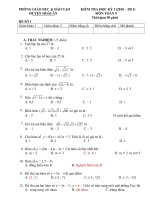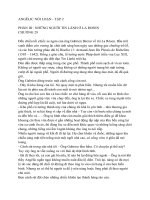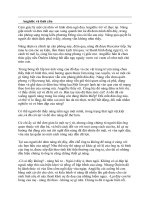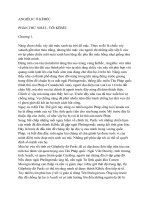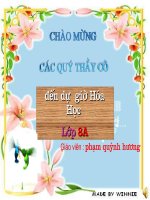bài giảng tinh khí huyết tân dịch
Bạn đang xem bản rút gọn của tài liệu. Xem và tải ngay bản đầy đủ của tài liệu tại đây (1.06 MB, 57 trang )
<span class="text_page_counter">Trang 1</span><div class="page_container" data-page="1">
Faculty of Traditional Medicine
<b>University of Medicine and Pharmacy</b>
<b>Các vật chất sống cơ bản</b>
ThS. Võ Thanh Phong
</div><span class="text_page_counter">Trang 2</span><div class="page_container" data-page="2">Faculty of Traditional Medicine
</div><span class="text_page_counter">Trang 3</span><div class="page_container" data-page="3">Faculty of Traditional Medicine
<b>University of Medicine and Pharmacy</b>
ThS. Võ Thanh Phong
</div><span class="text_page_counter">Trang 4</span><div class="page_container" data-page="4">Faculty of Traditional Medicine
<b>Tinh khí trong triết học</b>
•Khí là nguồn gốc căn bản tạo nên thế giới
•Khí vận động biến hố khơng ngừng
•Khí cầu nối con người và vạn vật
•Tinh khí trời đất hố sinh thành con người
<small>4</small>
</div><span class="text_page_counter">Trang 5</span><div class="page_container" data-page="5">Faculty of Traditional Medicine
</div><span class="text_page_counter">Trang 6</span><div class="page_container" data-page="6">Faculty of Traditional Medicine
(xuống Thạn và Bàng quang)
(đi vào tấu lý, cơ nhục)(từ tấu lý, cơ
nhục đi ra)
<i>Maciocia, Giovanni (2015), The foundations of Chinese medicine : a comprehensive text, Elsevier.</i>
</div><span class="text_page_counter">Trang 7</span><div class="page_container" data-page="7">Faculty of Traditional Medicine
<b>Khí vận động không ngừng</b>
<i>Maciocia, Giovanni (2015), The foundations of Chinese medicine : a comprehensive text, Elsevier.</i>
<b>Chu kỳ tuần hành của Vệ khí</b>
</div><span class="text_page_counter">Trang 8</span><div class="page_container" data-page="8">Faculty of Traditional Medicine
<b>Khí hóa sinh con người</b>
•<i>Tố vấn - Bảo mệnh tồn hình luận: “Người do khí của trời đất sinh ra </i>
và phải theo quy luật của bốn mùa mà tồn tại”
•Tinh khí của trời đất tương hợp mới có thể thành người
•<i>Hồi nam tử: “Khí trọc thành trùng, khí thanh thành người” </i>
<i>Maciocia, Giovanni (2015), The foundations of Chinese medicine : a comprehensive text, Elsevier.</i>
</div><span class="text_page_counter">Trang 9</span><div class="page_container" data-page="9">Faculty of Traditional Medicine
<b>Khí liên kết con người – vạn vật</b>
•Giữa trời đất vạn vật tràn đầy khí vạn vật tương hỗ với nhau
•<i>Linh khu - Tuế lộ: “Người tương thâm với trời đất, tương ứng với </i>
nhật nguyệt”
<i>Maciocia, Giovanni (2015), The foundations of Chinese medicine : a comprehensive text, Elsevier.</i>
</div><span class="text_page_counter">Trang 10</span><div class="page_container" data-page="10">Faculty of Traditional Medicine
<b>Tinh khí trong YHCT</b>
•Tinh khí là động lực hoạt động sống của con người
•Tinh khí đầy đủ thì hoạt động sống được duy trì bình thường
•Vận động của khí trong người cần được điều hồ thơng đạt
•Quan hệ tinh, khí, thần
<i>Maciocia, Giovanni (2015), The foundations of Chinese medicine : a comprehensive text, Elsevier.</i>
</div><span class="text_page_counter">Trang 11</span><div class="page_container" data-page="11">Faculty of Traditional Medicine
<b>Tinh khí trong YHCT</b>
oVật chất cơ bản để duy trì cấu trúc và các chức năng cơ bản của cơ thể
oVật chất để duy trì nịi giống trữ ở thận
•<i><b>Tinh tiên thiên: vật chất ban đầu để xây dựng cơ thể và duy trì nịi </b></i>
</div><span class="text_page_counter">Trang 12</span><div class="page_container" data-page="12">Faculty of Traditional Medicine
<b>Thận tinh</b>
<i>Maciocia, Giovanni (2015), The foundations of Chinese medicine : a comprehensive text, Elsevier.</i>
<b>Tinh tiên thiên</b>
<b>Tinh hậu thiên</b>
<b>Thận tinh</b>
</div><span class="text_page_counter">Trang 13</span><div class="page_container" data-page="13">Faculty of Traditional
<b>Tinh tiên thiên</b>
<b>Tinh hậu thiên</b>
Thúc đẩy khí
<i>Maciocia, Giovanni (2015), The foundations of Chinese medicine : a comprehensive text, Elsevier.</i>
</div><span class="text_page_counter">Trang 14</span><div class="page_container" data-page="14">Faculty of Traditional Medicine
</div><span class="text_page_counter">Trang 15</span><div class="page_container" data-page="15">Faculty of Traditional Medicine
<b>Sinh trưởng, phát triển, sinh sản</b>
Dương tinh từ cha
Âm tinh từ mẹ
Thụ thaiTinh của
bào thai
Từ lúc sinh
Dậy thì
Kinh nguyệt ở nữ
Tinh trùng ở nam
Hỏa của Mệnh môn
</div><span class="text_page_counter">Trang 16</span><div class="page_container" data-page="16">Faculty of Traditional Medicine
<b>Sinh trưởng, phát triển, sinh sản</b>
Thiên quý hết56 – tinh thiểu49 – mãn kinhTinh khí suy64
</div><span class="text_page_counter">Trang 17</span><div class="page_container" data-page="17">Faculty of Traditional Medicine
<b>Cơ sở của Thận khí</b>
<b>Thận khí</b>
<b>Thận âmThận tinh</b>
<b>Thận dương</b>
<i>Maciocia, Giovanni (2015), The foundations of Chinese medicine : a comprehensive text, Elsevier.</i>
</div><span class="text_page_counter">Trang 18</span><div class="page_container" data-page="18">Faculty of Traditional Medicine
</div><span class="text_page_counter">Trang 19</span><div class="page_container" data-page="19">Faculty of Traditional Medicine
<b>University of Medicine and Pharmacy</b>
ThS. Võ Thanh Phong
</div><span class="text_page_counter">Trang 20</span><div class="page_container" data-page="20">Faculty of Traditional Medicine
<b>Khái niệm</b>
•<i><b>Khí tự nhiên: yếu tố cơ bản tạo ra vũ trụ và thông qua chuyển động, </b></i>
biến đổi và chuyển hố của nó tạo ra tồn bộ vũ trụ, bao gồm cơ thể con người và hoạt động sống
•<i><b>Khí trong y học: chỉ vật chất dinh dưỡng trong cơ thể con người </b></i>
cũng như hoạt động chức năng của nó
•<i><b>Khí tiên thiên: khí có sẵn từ khi sinh ra</b></i>
•<i><b><sub>Khí hậu thiên: khí thu được sau khi sinh được tạo ra từ khí của thức </sub></b></i>
ăn và khí trời ở phế
<small>20</small>
</div><span class="text_page_counter">Trang 21</span><div class="page_container" data-page="21">Faculty of Traditional Medicine
<b>Khái niệm</b>
•<i><b>Tơng khí: sự kết hợp của tinh khí hố đồ ăn thức uống và khí trời hít </b></i>
thở vào trong ngực, làm động lực cho sự tuần hoàn máu, hơ hấp, tiếng nói, vận động của cơ thể
•<i><b>Vệ khí: khí di chuyển bên ngồi mạch, bảo vệ bề mặt cơ thể tránh </b></i>
khỏi ngoại tà
•<i><b>Dinh/doanh khí: khí di chuyển bên trong mạch, dinh dưỡng tất cả </b></i>
các cơ quan và tổ chức trong cơ thể
•<i><b><sub>Tân khí: (1) tân dịch; (2) khí được vận hành bởi dịch</sub></b></i>
<small>21</small>
</div><span class="text_page_counter">Trang 22</span><div class="page_container" data-page="22">Faculty of Traditional Medicine
<b>Khái niệm</b>
•<i><b>Chính khí: chỉ các chức năng bình thường của cơ thể con người, </b></i>
bao gồm khả năng tự điều hồ, thích nghi
•<i><b>Chân khí: sự kết hợp của khí tiên thiên và khí hậu thiên làm nền </b></i>
tảng vật chất cho cơ thể và là động lực cho tất cả các chức năng sống
•<i><b>Ngun khí: sự kết hợp của khí tiên thiên và khí hậu thiên làm thành </b></i>
khí chủ yếu nhất của cơ thể con người
<small>22</small>
</div><span class="text_page_counter">Trang 23</span><div class="page_container" data-page="23">Faculty of Traditional Medicine
Phế
</div><span class="text_page_counter">Trang 24</span><div class="page_container" data-page="24">Faculty of Traditional Medicine
•<i><b>Trung khí: khí của trung tiêu, là cơ sở vật chất và động lực cho các </b></i>
hoạt động chức năng của tỳ, vị và tiểu trường gồm tiêu hoá, hấp thu, vận chuyển, thăng thanh giáng trọc
•<i><b><sub>Kinh khí: khí chạy qua các đường kinh, cũng là khí của lạc</sub></b></i>
<small>24</small>
</div><span class="text_page_counter">Trang 25</span><div class="page_container" data-page="25">Faculty of Traditional Medicine
<b>Khái niệm</b>
•<i><b>Khí hố: thuật ngữ chung chỉ những thay đổi khác nhau do hoạt </b></i>
động của khí, cụ thể là chuyển hố và biến đổi lẫn nhau giữa tinh, khí, huyết và tân dịch
•<i><b>Khí cơ: chuyển động của khí gồm thăng giáng xuất nhập là những </b></i>
hình thức chuyển động cơ bản
•<i><b>Âm khí: phần âm của khí, khí của cơ sở vật chất</b></i>
•<b><sub>Dương khí: phần dương của khí, khí của hoạt động chức năng</sub></b>•<i><sub>Tinh huyết đồng nguyên</sub></i>
•<i><sub>Tân huyết đồng nguyên</sub></i>
<small>25</small>
</div><span class="text_page_counter">Trang 26</span><div class="page_container" data-page="26">Faculty of Traditional Medicine
Phòng ngự
Thăng đề
Cố nhiếp
</div><span class="text_page_counter">Trang 27</span><div class="page_container" data-page="27">Faculty of Traditional Medicine
<b>Chuyển hóa của khí</b>
Vệ khíDinh khí
Tinh khíNgun khí
HuyếtTân dịch
<b>Khí </b>
<i>Maciocia, Giovanni (2015), The foundations of Chinese medicine : a comprehensive text, Elsevier.</i>
</div><span class="text_page_counter">Trang 28</span><div class="page_container" data-page="28">Faculty of Traditional Medicine
(xuống Thạn và Bàng quang)
(đi vào tấu lý, cơ nhục)(từ tấu lý, cơ
</div><span class="text_page_counter">Trang 29</span><div class="page_container" data-page="29">Faculty of Traditional Medicine
<b>Khí cơ</b>
<i>Maciocia, Giovanni (2015), The foundations of Chinese medicine : a comprehensive text, Elsevier.</i>
</div><span class="text_page_counter">Trang 30</span><div class="page_container" data-page="30">Faculty of Traditional Medicine
<b>Khí cơ</b>
<i>Maciocia, Giovanni (2015), The foundations of Chinese medicine : a comprehensive text, Elsevier.</i>
Hạ giángNạp khí
(khí từ khí hóa BQ lên Phế)
</div><span class="text_page_counter">Trang 31</span><div class="page_container" data-page="31">Faculty of Traditional Medicine
(xuống tiểu trường)
<i>Maciocia, Giovanni (2015), The foundations of Chinese medicine : a comprehensive text, Elsevier.</i>
</div><span class="text_page_counter">Trang 32</span><div class="page_container" data-page="32">Faculty of Traditional Medicine
</div><span class="text_page_counter">Trang 33</span><div class="page_container" data-page="33">Faculty of Traditional Medicine
<b>University of Medicine and Pharmacy</b>
ThS. Võ Thanh Phong
</div><span class="text_page_counter">Trang 34</span><div class="page_container" data-page="34">Faculty of Traditional Medicine
<b>Khái niệm</b>
•chất dịch màu đỏ giàu chất dinh dưỡng
•tác dụng tư nhuận
•chảy trong huyết mạch đi khắp tồn thân
•chất cơ bản cấu tạo và duy trì hoạt động sống của cơ thể
<small>34</small>
</div><span class="text_page_counter">Trang 35</span><div class="page_container" data-page="35">Faculty of Traditional Medicine
<b>Nguồn gốc</b>
Khí hậu thiên
Khí tiên thiên
</div><span class="text_page_counter">Trang 36</span><div class="page_container" data-page="36">Faculty of Traditional Medicine
Cốc khí
</div><span class="text_page_counter">Trang 37</span><div class="page_container" data-page="37">Faculty of Traditional Medicine
<b>Chức năng</b>
•Ni dưỡng và tư nhuận tồn thân
•Nhà của Thần
•Huyết là cơ sở vật chất của hoạt động thần chí
•Huyết duy trì sự bình hằng của âm - dương
•Hình thành kinh nguyệt
<i>Maciocia, Giovanni (2015), The foundations of Chinese medicine : a comprehensive text, Elsevier.</i>
</div><span class="text_page_counter">Trang 38</span><div class="page_container" data-page="38">Faculty of Traditional Medicine
<b>Quan hệ khí huyết</b>
Sinh thànhVận hành
Cố nhiếpMẹ của khí
<i>Maciocia, Giovanni (2015), The foundations of Chinese medicine : a comprehensive text, Elsevier.</i>
</div><span class="text_page_counter">Trang 39</span><div class="page_container" data-page="39">Faculty of Traditional Medicine
<b>University of Medicine and Pharmacy</b>
<b>Tân dịch</b>
ThS. Võ Thanh Phong
</div><span class="text_page_counter">Trang 40</span><div class="page_container" data-page="40">Faculty of Traditional Medicine
<b>Khái niệm</b>
•<i><b>Tân: sinh ra từ đồ ăn thức uống, theo khí của tam tiêu phân bố đến </b></i>
khoảng cơ nhục, bì phu để ơn dưỡng cơ nhục, tươi nhuận da lơng
•Tân bao gồm: nước bọt, dịch vị, dịch trường, nước tiểu, mồ hơi
•<i><b>Dịch: từ đồ ăn uống hóa sinh, theo huyết đi toàn thân, chứa lại ở các </b></i>
các khiếu, dịch não tủy, khớp xương
<small>40</small>
</div><span class="text_page_counter">Trang 41</span><div class="page_container" data-page="41">Faculty of Traditional Medicine
<b>Tân và Dịch</b>
<i><b>Tính chất</b></i>Trong, lỏng, lỗngĐục, nặng, đặc
<i><b>Chức năng</b></i>Tư nhuận bì phu, cơ nhục. Bài tiết thành mồ hôi, nước mắt, nước bọt và các
</div><span class="text_page_counter">Trang 42</span><div class="page_container" data-page="42">Faculty of Traditional Medicine
<b>Chức năng</b>
•Tác dụng nhu dưỡng và tư nhuận
•Hóa sinh huyết dịch
•Điều tiết thăng bằng âm dương của cơ thể
•Bài tiết sản phẩm chuyển hóa
•Vận chuyển khí đi khắp tồn thân
<small>42</small>
</div><span class="text_page_counter">Trang 43</span><div class="page_container" data-page="43">Faculty of Traditional Medicine
<b>Chuyển hóa</b>
<i>Maciocia, Giovanni (2015), The foundations of Chinese medicine : a comprehensive text, Elsevier.</i>
Đến bì mao và cơ nhục
Thượng tiêu
Trung tiêu
Hạ tiêuNhuận
Nước tiểuPhân
Tái hấp thu(Tuyên phát)
Hạ giángPhế
Tỳ Vị (ăn uống)
Tiểu trường
Đại trường
Bàng quangThanh
TrọcKhí
hóa
</div><span class="text_page_counter">Trang 44</span><div class="page_container" data-page="44">Faculty of Traditional Medicine
Tư dưỡng
</div><span class="text_page_counter">Trang 45</span><div class="page_container" data-page="45">Faculty of Traditional Medicine
<b>Quan hệ huyết, tân dịch</b>
</div><span class="text_page_counter">Trang 46</span><div class="page_container" data-page="46">Faculty of Traditional Medicine
<b>University of Medicine and Pharmacy</b>
ThS. Võ Thanh Phong
</div><span class="text_page_counter">Trang 47</span><div class="page_container" data-page="47">Faculty of Traditional Medicine
<b>Khái niệm</b>
1.Quy luật nội tại về sự vận động, biến hoá của vật chất trong tự nhiên
2.Toàn bộ những biểu hiện bên ngoài những hoạt động của sinh vật
3.Chủ một hoạt động chức năng trong cơ thể “tâm tàng thần”
4.Hoạt động tư duy ý thức tinh thần của con người
<small>47</small>
</div><span class="text_page_counter">Trang 48</span><div class="page_container" data-page="48">Faculty of Traditional Medicine
<b>Khái niệm</b>
•<i><b>Thần (mind - </b></i>神 ): các hoạt động tinh thần, chỉ tinh thần, tỉnh táo, suy nghĩ, cảm giác
•<i><b>Thần (spirit - </b></i>神 ): các hoạt động tinh thần
•<i><b>Thần (vitality - </b></i>神 ): các biểu hiện chức năng sống
•<i><b>Tinh thần (essence-spirit): trạng thái tinh thần hay tình cảm, phản ánh sức </b></i>
khoẻ của tinh
•<i><b>Hồn (ethereal soul - </b></i>魂 ): phần đạo đức hoặc tinh thần của con người
•<i><b>Phách (corporeal soul - </b></i>魄 ): hình ảnh động của thần
•<i><b>Ý (ideation - </b></i>意 ): hoạt động hoặc sức mạnh của suy nghĩ và đưa ra ý tưởng
•<i><b>Chí (will -</b></i>志 ): sức mạnh ý chí mà nhờ đó con người điều khiển ý nghĩ và hành động
<small>48</small>
</div><span class="text_page_counter">Trang 49</span><div class="page_container" data-page="49">Faculty of Traditional Medicine
<b>Khái niệm</b>
<i>Maciocia, Giovanni (2015), The foundations of Chinese medicine : a comprehensive text, Elsevier.</i>
Khói thuốc bay lên
</div><span class="text_page_counter">Trang 50</span><div class="page_container" data-page="50">Faculty of Traditional Medicine
<b>Khái niệm</b>
•Âm dương lưỡng tinh kết hợp nhau sản sinh sự hoạt động của sinh mạng
<i><b>gọi là Thần</b></i>
•<i><b>Sự hoạt động tinh thần theo sự vãng lai của thần khí gọi là Hồn</b></i>
•Chủ sự hoạt động của khí quan dựa vào sự xuất nhập của tinh khí gọi là
•<i><b>Gánh chịu sự cảm thụ của sự vật, đồng thời tiến hành phân tích gọi là Tâm</b></i>
•<i><b>Trong lịng có ý niệm mà chuẩn bị đi làm gọi là Chí</b></i>
•<i><b>Vì để thực hiện ý nguyện mà suy đi nghĩ lại gọi là Tư</b></i>
•<i><b>Suy nghĩ ắt sinh hồi nghi, lo lắng gọi là Lự</b></i>
•<i><b>Suy nghĩ kỹ lưỡng mà đặt ra cách xử lý tương ứng với sự vật gọi là Trí</b></i>
<small>50</small>
</div><span class="text_page_counter">Trang 51</span><div class="page_container" data-page="51">Faculty of Traditional Medicine
</div><span class="text_page_counter">Trang 52</span><div class="page_container" data-page="52">Faculty of Traditional Medicine
<b>Thần và trí nhớ</b>
Trí nhớ học tậpTrí nhớ xa
</div><span class="text_page_counter">Trang 53</span><div class="page_container" data-page="53">Faculty of Traditional Medicine
<b>Thần và quyết định</b>
<i>Maciocia, Giovanni (2015), The foundations of Chinese medicine : a comprehensive text, Elsevier.</i>
<b>Thực hiện ra </b>
<b>quyết định</b>
Quyết đoánĐộng lực và trí
Khả năng phân biệt và phản biệnTinh thần
sáng suốt và toàn
vẹn
</div><span class="text_page_counter">Trang 54</span><div class="page_container" data-page="54">Faculty of Traditional Medicine
<b>Tinh khí thần</b>
•<i><b>Tinh hố khí, khí hố tinh, tinh khí hố lẫn nhau</b></i>
•<i><b>Tinh khí sinh thần, tinh khí dưỡng thần, thần thống ngự tinh và khí</b></i>
•<i><b>Tâm khí thúc đẩy vận hành huyết dịch và cũng là động lực của </b></i>
</div><span class="text_page_counter">Trang 55</span><div class="page_container" data-page="55">Faculty of Traditional Medicine
<i>Maciocia, Giovanni (2015), The foundations of Chinese medicine : a comprehensive text, Elsevier.</i>
</div><span class="text_page_counter">Trang 56</span><div class="page_container" data-page="56">